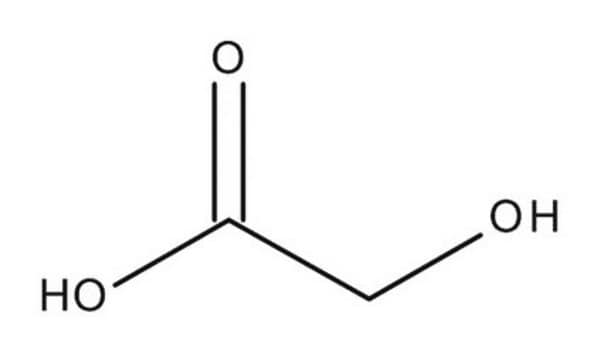推荐产品
等級
SAJ special grade
化驗
≥98.0%
形狀
crystalline
存貨情形
available only in Japan
mp
75-80 °C (lit.)
SMILES 字串
OCC(O)=O
InChI
1S/C2H4O3/c3-1-2(4)5/h3H,1H2,(H,4,5)
InChI 密鑰
AEMRFAOFKBGASW-UHFFFAOYSA-N
正在寻找类似产品? 访问 产品对比指南
訊號詞
Danger
危險聲明
危險分類
Acute Tox. 4 Inhalation - Eye Dam. 1 - Skin Corr. 1B
儲存類別代碼
8A - Combustible corrosive hazardous materials
水污染物質分類(WGK)
WGK 1
閃點(°F)
>572.0 °F - (decomposition)
閃點(°C)
> 300 °C - (decomposition)
個人防護裝備
Eyeshields, Faceshields, Gloves, type P3 (EN 143) respirator cartridges
Ingela Bjurhager et al.
Biomacromolecules, 13(8), 2521-2527 (2012-07-10)
In 1628, the Swedish warship Vasa capsized on her maiden voyage and sank in the Stockholm harbor. The ship was recovered in 1961 and, after polyethylene glycol (PEG) impregnation, it was displayed in the Vasa museum. Chemical investigations of the
W H Porter et al.
Journal of toxicology. Clinical toxicology, 39(6), 607-615 (2002-01-05)
To correlate serum glycolic acid levels with clinical severity and outcome in ethylene glycol poisoning and to determine if glycolic acid levels are predictive of renal failure and the need for hemodialysis. We measured serum ethylene glycol and glycolic acid
D Jacobsen et al.
The American journal of medicine, 84(1), 145-152 (1988-01-01)
Ethylene glycol and glycolate kinetics were studied in two cases of ethylene glycol intoxication with maximal ethylene glycol/glycolate concentrations of 40.9/26.8 and 56.4/22.4 mmol/liter, respectively. Both patients survived, but with prolonged renal failure, upon treatment with bicarbonate, ethanol, and hemodialysis.
Genqiang Zhang et al.
Advanced materials (Deerfield Beach, Fla.), 24(34), 4609-4613 (2012-06-26)
Novel ZnMn(2)O(4) ball-in-ball hollow microspheres are fabricated by a facile two-step method involving the solution synthesis of ZnMn-glycolate hollow microspheres and subsequent thermal annealing in air. When evaluated as an anode material for lithium-ion batteries, these ZnMn(2)O(4) ball-in-ball hollow microspheres
Thea R Pick et al.
Proceedings of the National Academy of Sciences of the United States of America, 110(8), 3185-3190 (2013-02-06)
Photorespiratory carbon flux reaches up to a third of photosynthetic flux, thus contributes massively to the global carbon cycle. The pathway recycles glycolate-2-phosphate, the most abundant byproduct of RubisCO reactions. This oxygenation reaction of RubisCO and subsequent photorespiration significantly limit
我们的科学家团队拥有各种研究领域经验,包括生命科学、材料科学、化学合成、色谱、分析及许多其他领域.
联系技术服务部门







